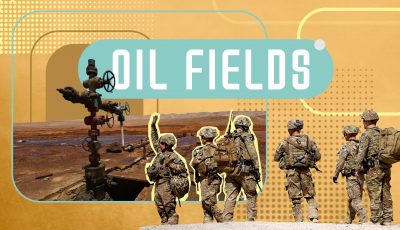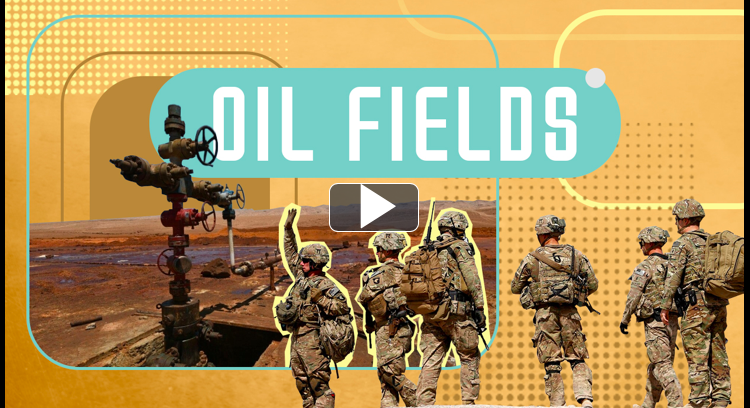Video: Syrian Oil and US Troop Withdrawal, Explained

The United States is to keep forces at the oil fields in Syria despite the troops’ withdrawal from the north of the country. The formal justification of the move is the need to “deny ISIS access” to the oil fields. Defense Secretary Mark Esper said that the US military is already “taking some actions” to strengthen and reinforce their position in Deir Ezzor. This, Esper said, will include “some mechanized forces”.
US military convoys already started entering Syria from Iraq and moving towards the US-controlled oil fields on the eastern bank of the Euphrates. The Pentagon provided few details regarding numbers of troops and equipment that will remain in the area. Media reports speculate that around 500 personnel reinforced with dozens of pieces of military equipment will be stationed there. For example, Newsweek reported that the US is seeking to deploy a half of an US Army armored brigade combat team battalion that includes as many as 30 Abrams battle tanks to the oil fields. The US is also going to keep its military garrison in the al-Tanf area, on the Damascus Baghdad highway, where about 150-200 troops remain.
The version of the troops’ withdrawal from Syria that the media is trying to sell its audience says that the US is leaving the country. In reality, the US actions look more like re-deployment than withdrawal.
Firstly, the withdrawal of “a majority of 1,000 troops” is hardly possible if, at the same time, 650-700 troops are to remain in the Deir Ezzor oil fields and al-Tanf.
Secondly, the Trump administration, including the Defense Secretary, said that it was moving troops out of northern Syria, but not that they would be leaving the country. Trump himself described the withdrawal from Syria as a “process”.
Thirdly, the US military convoys which left northern Syria during the active phase of Turkey’s Operation Peace Spring for western Iraq are now returning. Dozens of US military vehicles accompanied by fuel tankers entered Syria on October 26 and 27 alone. US forces also remained deployed at the Qasrak base on the Tell Tamr-Qamishli highway.
Therefore, in the best case the US contingent is being reduced, while the rest of the forces just change their deployment area. The stance of Iraq, which at the highest level rejected the long-term presence of the US troops withdrawing from Syria to western Iraq, also played its own role. Some experts initially suggested that Washington could keep forces on the Iraqi side of the border to project military power to Syria while keeping the troop withdrawal promise at the same time. However, this plan caused too much resistance from the Iraqi government, which is already in much closer relations with Iran than the US has ever wanted.
Another factor is money. The control of a part of Syrian oil does not impact the US economy in general. However, it does open particular prospects for the US campaign in the region and gives the Trump administration additional leverages of pressure on Syria and its allies.
Before 2011, Syria had a lucrative oil industry, pumping about 400,000 barrels a day and having 2.5 billion barrels of reserves. The ensuing war and wide-scale Western sanctions devastated the country’s economy, cutting production by around 90% and forcing the Assad government to rely heavily on foreign imports of oil, mainly from Iran.
The known oil reserves are mainly in the eastern part of the country near its border with Iraq and along the Euphrates River. The largest and most mature fields are the Omar and Jbessa fields, which reportedly had production capacities of 100,000 and 200,000 barrels a day, respectively, in 2010. This is the area where the US is planning to keep its military presence. It is estimated that around 75% of Syrian oil reserves are under the direct or indirect control of the US. A number of smaller fields are located in the center of the country, which is controlled by the Syrian Army, and in the country’s northeast, which is now under the joint control of the Syrian Army and the Kurdish-led Syrian Democratic Forces (SDF).
When the SDF and the US-led coalition seized the fields, the revenue from smuggling of Syrian oil was estimated at around $10 million a month with the price of around $30 per barrel. However, thanks to assistance from companies affiliated with US intelligence agencies and private military companies the oil output and thus revenue grew significantly.
According to an October 26 report by the Russian Defense Ministry, the US military and private military contractors are now actively involved in protecting and managing oil smuggling in eastern Syria. The oil production itself is carried out using equipment provided by Western corporations bypassing all US sanctions. The oil exportation is implemented by the US-controlled company «Sedkab», created under the so-called Autonomous Administration of Eastern Syria, a political body created by the SDF, when US troops were deployed in northern Syria. The income from the smuggling goes through brokerage companies interacting with various accounts of US private military companies and US intelligence agencies. The Russian side says that the barrel cost of smuggled Syrian oil is $38 and estimates a monthly revenue for the US “business” involved in the operation of over $30 million.
The business interests of US agencies and entities involved in the operation offer more reasons for the US presence in the area. It can be expected that if the situation in this part of Syria remains unchanged, the Trump administration will indeed go forward with its withdrawal “process” and more and more US troops will be replaced by US-linked private military contractors. Meanwhile US agencies and private military corporations will use revenue from the oil smuggling for further operations across the Middle East.
*
Note to readers: please click the share buttons above or below. Forward this article to your email lists. Crosspost on your blog site, internet forums. etc.
We call upon Global Research readers to support South Front in its endeavors.
If you’re able, and if you like our content and approach, please support the project. Our work wouldn’t be possible without your help: PayPal: [email protected] or via: http://southfront.org/donate/ or via: https://www.patreon.com/southfront


